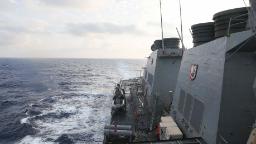[ad_1]

Seoul, South Korea
CNN
—
A day after China said it drove a US Navy destroyer away from Beijing-claimed waters in the South China Sea, the US 7th Fleet said the same warship sailed through those waters to challenge the Chinese claims.
The “guided-missile destroyer USS Milius asserted navigational rights and freedoms in the South China Sea near the Paracel Islands, consistent with international law,” a statement from 7th Fleet spokesperson Lt. jg. Luka Bakic said.
The warship conducted what the US Navy calls a “freedom of navigation operation,” or FONOP, Bakic said, “challenging the restrictions on innocent passage imposed by the People’s Republic of China (PRC), Taiwan, and Vietnam.”
All three claim the Paracels, known as the Xishas in China, a group of about 130 small atolls, the biggest of which are home to Chinese military bases.
The US statement also said the Milius challenged China’s claim to “straight baselines enclosing the Paracels,” meaning Beijing’s claims to waters between the islands, even when those waters are outside the internationally recognized 12-nautical-mile limit from a coastline for territorial waters.
China reacted angrily to the presence of the US warship.
“The actions of the U.S. military have seriously violated China’s sovereignty and security and seriously violated international law,” Tan Kefei, spokesperson for the Defense Ministry, said in a statement.
“The guided-missile destroyer USS Milius broke into China’s Xisha territorial waters again without the approval of the Chinese government, undermining peace and stability in the South China Sea,” Tan said.
On Thursday, Beijing said the Milius was driven away from the Paracels by People’s Liberation Army forces, a claim that was called “false” by the US 7th Fleet.
Beijing has made similar claims after other FONOPs, which the US conducts regularly around the Paracels and the Spratly Islands (Nansha Islands in China) to the south, where China has also built up military fortifications.
The Paracels are located east of Da Nang, Vietnam, and south of China’s Hainan Island.
But Beijing claims almost all of 1.3 million-square-mile South China Sea as its sovereign territory.
It regularly makes statements that any US Navy operations there inflame tensions and show that Washington, and its partners who keep a naval presence in the waterway, are damaging the region’s security.
The area around the Paracels was the site of a tense encounter between a Chinese warplane and US reconnaissance jet in February that was witnessed by a CNN crew.
Then and now, Washington is consistent in its statements about its South China Sea operations.
“The operations demonstrate that the United States will fly, sail, and operate wherever international law allows – regardless of the location of excessive maritime claims and regardless of current events,” Friday’s statement, like many others before it, said.
In recent years, the South China Sea has emerged as a major potential flashpoint in the Asia Pacific.
Not only does the strategic waterway hold vast resources of fish, oil and gas, but about a third of global shipping passes through it – worth about $3.4 trillion in 2016, according to the Center for Strategic and International Studies’ (CSIS) China Power Project.
China also conducts regular military exercises in much of the South China Sea and maintains a large presence of coast guard and fishing vessels in the disputed waters – which has frequently stoked tensions with its neighbors.
[ad_2]
Source link





